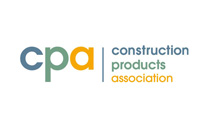

Construction Products Association (CPA) chairman John Sinfield launched three new strategic objectives and a new logo for the Association, at its annual Spring Lunch on 19 April, 2016.
Speaking before an audience of 500 senior industry leaders and government officials, Mr Sinfield, managing director of Knauf Insulation for Northern Europe, paid compliments to CPA chief executive Diana Montgomery and her team, for the new logo and the Association's new website. He said: “The change is more than skin deep as there has been significant effort put in behind the scenes to rethink and refocus the CPA’s objectives and strategy. More than ever these are clearly centred on responding to the needs of the members."
The three objectives outlined by Mr Sinfield were:
To increase the recognition for the industry, Mr Sinfield said the CPA is known as the voice of the industry. "That’s a turn of phrase that sometimes gets overused, but as the umbrella trade association representing 85% by value of all the manufacturers and merchants, we have a clear mandate from our members," he said. "This support, together with our expertise and insight, means we are often the first point of contact for politicians, civil servants and the media seeking information and advice about policies that affect not only your business but the wider construction supply chain too."
Mr Sinfield said the CPA has sometimes had to fight hard to remind government that the industry accounts for more than a third of the UK's total construction output, and works across every constituency in the country. "While we may not be as sexy as the makers of F1 cars or the latest fighter jet, manufacturers of construction products are just as innovative and employ more people in the UK than automotive and aerospace manufacturers combined," he said. "To the government’s credit, they have been willing to listen to us and their support, for example, of the Construction Leadership Council bodes well for a productive working relationship with the construction supply chain.”
Addressing whether the CPA can help the construction products industry grow the market, Mr Sinfield said he believes the CPA can do this by providing information and addressing areas that are key to CPA members' success, such as economic forecasts and surveys. He said this information is indispensible to members' business development, offering "highly accurate insight into market data, growth opportunities and risks".
"Certainly in my role as managing director at Knauf, I can attest to the value of this information and how it can help my business grow," Mr Sinfield added. "Later this summer the economics team will also publish a regional, ‘hot-spot’ analysis, which many of you have said would be very useful."
Turning his attention to the skills shortage, Mr Sinfield said the CPA has started a pilot project with the help of CITB and a small number of members, to see whether 'product-user training' couold be put on a more formal footing with nationally recognised qualifications. This, he said, would ensure members' products are installed properly, and would help tradespeople be better trained with professional credentials.
The CPA has also been lobbying government on the importance of allowing its members to use Apprenticeship Levy vouchers to train the supply chain, as well as internal staff, which the CPA believes will help the industry make best use of the new levy.
Mr Sinfield also stressed the importance of embracing digital technology, both as the industry works towards BIM level 3 and in how it can help with industry collaboration and innovation.
Reducing Regulatory Risk
The CPA recently published a report that identified 132 current and pending UK and EU policies impacting on industry businesses, not including health and safety, finance, human resources or transportation issues.
With the complexity of these policies causing issues for the industry, Mr Sinfield stressed the work CPA does in protecting its members' interests, minimising barriers to doing business and seeking opportunities in the way new regulations are set out.
He said: "A perfect example is the ‘Every Home Matters’ Review, a major study of the framework of standards which offer consumers the information and protection they need when choosing home energy efficiency and renewable energy measures. It was commissioned late last year by DCLG and DECC and is led by BRE’s chief executive Dr Peter Bonfield. Peter specifically tasked the CPA to lead a critical work stream focused on fabric, involving not only of our own members but the entire sector. The Review is due to report later this month and we look forward to taking its proposals through to implementation.
“Until then, this role is a testament to our reputation, our expertise, an objective ability to develop consensus in difficult areas, and a track record of delivering. It is also another example of how the CPA is at the centre of major regulatory, technical and sustainability issues and risks impacting your business.”